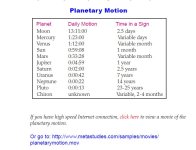MareSaturni
Hi everyone!
I am back with more weird questions, lol!
I'd like to know if there's an established number for the amount of degrees a planets moves in a certain amount of time. I am sure there must be a math calculation for that, but I wouldn't know how to do it. I have no idea how many degrees a day (or a month) represents.
Now, I know that different planets move at different 'speeds'... the Moon probably covers a lot of degrees in one single month, whereas Pluto must take a long time to cover the 30 degrees that make one Sign.
There's also the retrograde problem... when a planet is retrograde, although we know that this is an optical illusion of some sorts, does it actually walk backwards in the chart? Since the chart is really a representation from what we see, if the planets appear to be retrograde in the sky, this should also appear in the chart. No? If yes, then this would affect the calculation...
And there's also the fact that some planets never stay for too long away from each other, like Mercury and the Sun, or Venus and the Sun... I'd like to know more about this.
Thank you very much for any help you can give me on this!
I am back with more weird questions, lol!
I'd like to know if there's an established number for the amount of degrees a planets moves in a certain amount of time. I am sure there must be a math calculation for that, but I wouldn't know how to do it. I have no idea how many degrees a day (or a month) represents.
Now, I know that different planets move at different 'speeds'... the Moon probably covers a lot of degrees in one single month, whereas Pluto must take a long time to cover the 30 degrees that make one Sign.
There's also the retrograde problem... when a planet is retrograde, although we know that this is an optical illusion of some sorts, does it actually walk backwards in the chart? Since the chart is really a representation from what we see, if the planets appear to be retrograde in the sky, this should also appear in the chart. No? If yes, then this would affect the calculation...
And there's also the fact that some planets never stay for too long away from each other, like Mercury and the Sun, or Venus and the Sun... I'd like to know more about this.
Thank you very much for any help you can give me on this!





